
Glossodoris averni
Rudman, 1985
Order: NUDIBRANCHIA
Suborder: DORIDINA
Family: Chromodorididae
DISTRIBUTION
Known from Great Barrier Reef and down eastern Australia to mid New South Wales. Also Papua New Guinea, Philippines.
PHOTO
Coffs Harbour region, northern New South Wales, December,1990. 55mm long alive. PHOTO: Bill Rudman.
Characterised by the bright red border to the mantle. Other similarly coloured species are compared in the papers listed below. Probably has a wider distribution than recorded at present.
References:
• Rudman, W.B. (1985) The Chromodorididae (Opisthobranchia: Mollusca) of the Indo-West Pacific: Chromodoris aureomarginata, C. verrieri and C. fidelis colour groups. Zoological Journal of the Linnean Society 83: 241-299.
• Rudman, W.B. (1986a) The Chromodorididae (Opisthobranchia: Mollusca) of the Indo-West Pacific: The genus Glossodoris Ehrenberg (= Casella, H. & A. Adams). Zoological Journal of the Linnean Society 86(2): 101-184.
• Rudman, W.B. (1990b) The Chromodorididae (Opisthobranchia: Mollusca) of the Indo-West Pacific: further species of Glossodoris, Thorunna and the Chromodoris aureomarginata colour group. Zoological Journal of the Linnean Society, 100(3): 263-326.
Rudman, W.B., 1998 (December 1) Glossodoris averni Rudman, 1985. [In] Sea Slug Forum. Australian Museum, Sydney. Available from http://www.seaslugforum.net/find/glosaver
Related messages
Re: Glossodoris averni or G. angasi?
April 25, 2006
From: Bruce Wilkie

Concerning message #16394:
Hi Bill,
I have been through my photos and could only come up with two photos of one animal which may show a glimpse of sponge near the tail. I will put it on my list of things to keep an eye out for. It may take some time but I will try to find out what these guys are feeding on.
Locality: Manta Bommie Point Lookout North Stradbroke Island, 12 metres, Queensland Australia, Pacific ocean, 29 October 2005, rocky reef with sponges, hard & soft corals . Length: 40mm. Photographer: Bruce Wilkie.
Many Thanks,
Bruce Wilkie.
brucedwilkie@yahoo.com.au
Wilkie, B., 2006 (Apr 25) Re: Glossodoris averni or G. angasi?. [Message in] Sea Slug Forum. Australian Museum, Sydney. Available from http://www.seaslugforum.net/find/16410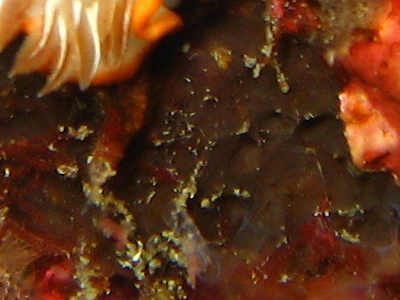
Dear Bruce,
Thanks for that. I suspect that's the sponge we are looking for, but it would certainly be nice to find it somwhere there weren't so many other possible 'spongy' items nearby.
Best wishes,
Bill Rudman
Re: Glossodoris averni or G. angasi?
April 20, 2006
From: Bruce Wilkie
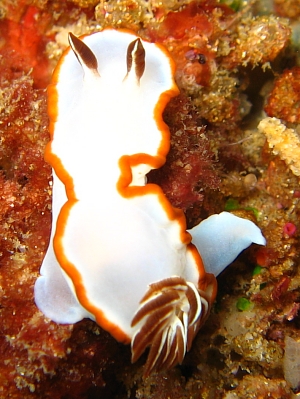
Concerning message #16350:
Hi Bill,
Have been reading Nerida`s message (#16356) about this brown form of G. averni being similar to Glossodoris sp.3. I didn`t come across these animals when I was doing my searches. Maybe that was just as well, as it would have confused me even further.
I have included another 3 photos of the brown form of G. averni for your records.
Upper right: Manta Bommie, 17th December 2005, Depth 11 m, Temp 25 deg c. Middle left: Manta Bommie, 30th December 2005, Depth 12 m, Temp 26 deg c. Middle right, Lower right: Manta Bommie Point Lookout North Stradbroke Island, 12 metres, Queensland Australia, Pacific ocean, 4th December 2005, rocky reef with sponges, hard & soft corals . Length: 40 mm. Photographer: Bruce Wilkie.
Many Thanks,
Bruce Wilkie.
brucedwilkie@yahoo.com.au

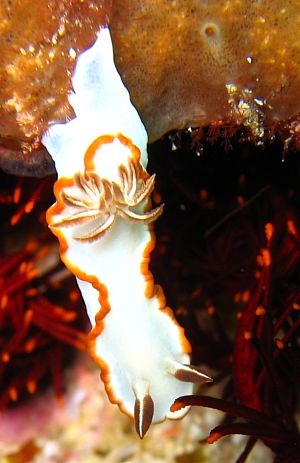

Dear Bruce,
The more [photos] the merrier ! At present I'll keep them all on the G. averni page so I don't lose them again but it doesn't mean I have no doubts about their identity.
One interesting thing in these three photos is that I can see a potential food sponge in the two middle photos [see closeup photo alongside]. If you could check through your photos and see if this sponge appears in any of your other photos I would be grateful. It's a sponge which often is overgrown so it's possibly present in your earlier shots but effectively invisible. It would be nice to know what it ate, even if we are not sure what it is.
Best wishes,
Bill Rudman
Re: Glossodoris averni or G. angasi?
April 19, 2006
From: Bruce Wilkie
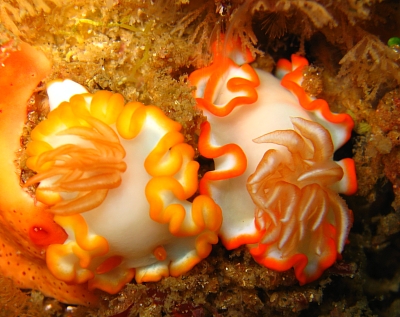
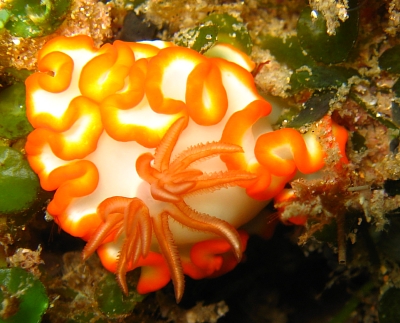
Concerning message #16306:
Hi Bill,
Thanks for setting me straight on these animals.
Here are some more photo`s which are what I would think are more typical examples of G. averni. They are also what I based my identification on.
Upper photo: 31 December 2005, Flat Rock, North Stradbroke Island, Queensland Australia, Pacific ocean. Depth 15 mts, Temp 26 deg C. Middle photo: 18 December 2005, Flat Rock, North Stradbroke Island, Depth 14 mts, Temp 25 deg C. Lower photo: Manta Bommie, Point Lookout, North Stradbroke Island, 12 metres, Queensland Australia, Pacific ocean, 7 January 2006, rocky reef with sponges, hard & soft corals . Length: 50 mm. Photographer: Bruce Wilkie.
Many Thanks,
Bruce Wilkie.
brucedwilkie@yahoo.com.au
Wilkie,B, 2006 (Apr 19) Re: Glossodoris averni or G. angasi?. [Message in] Sea Slug Forum. Australian Museum, Sydney. Available from http://www.seaslugforum.net/find/16350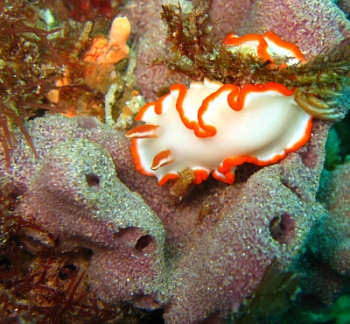
Dear Bruce,
As you will see from Nerida's message [#16356], I previously thought the brown bordered animal was different [see Glossodoris sp. 3]. Among other things it lacks a coloured border to the foot. Certainly your earlier animals seem to lack a colour border to the foot so perhaps I was right previously - or perhaps as Nerida implies, we need to find out more about this 'species' or colour form which seems to straddle the Queensland - New South wales border. As with many of these species, we really don't know enough about G. averni to decide whether animals with and without a colour border to the foot can be considered part of its colour variability.
Certainly the four animals illustated here at least show the variability in the degree of folding of the mantle edge.
Best wishes,
Bill Rudman
Re: Glossodoris averni or G. angasi?
April 19, 2006
From: Nerida Wilson
Concerning message #16306:
Hi Bill and Bruce,
I think the animals that Bruce has found are what we had tentatively called Glossodoris sp. 3 on the SSF. They may indeed turn out to be some kind of colour form of G. averni, but differences in the body texture/rigidity etc make me think they are different. Whatever they are, they seem to be common in the Sunshine Coast/Brisbane area.
Cheers
Nerida
wilsong@auburn.edu
Wilson, N.G., 2006 (Apr 19) Re: Glossodoris averni or G. angasi?. [Message in] Sea Slug Forum. Australian Museum, Sydney. Available from http://www.seaslugforum.net/find/16356Thanks Nerida,
I had a clear picture of your photo in my mind but couldn't find it when I was replying to Bruce. Clearly we need to know more about 'true' G. averni as well as the brown-edged one.
Best wishes,
Bill Rudman
Glossodoris averni or G. angasi?
April 14, 2006
From: Bruce Wilkie
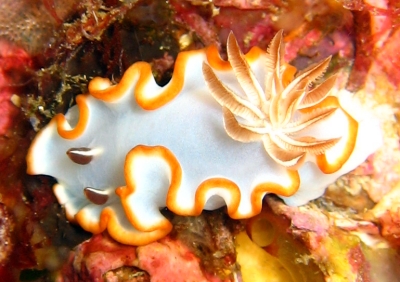
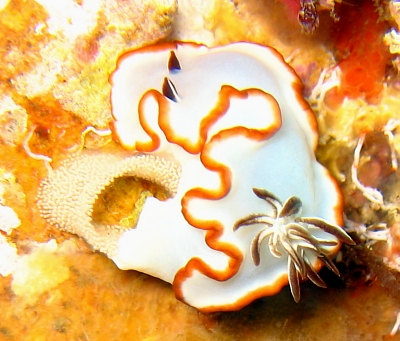
Hi Bill,
I have been doing a lot of um-ing and ah-ing over these animals. I originally had them listed under Glossodoris averni, until I had a closer look at them I noticed several differences.
1. The mantle colour is more brown than yellow/orange as in G. averni.
2. The colour of the rhinophores and gills are black. In G. averni they seem to be similar colour to the mantle border.
3. In G. averni the mantle border has a lot more folds and ruffles.(except in photo 1 )
Locality: Upper photo: Manta Bommie Point Lookout North Stradbroke Island, 12 metres, Queensland Australia, Pacific Ocean, 01 November 2005, rocky reef with sponges, hard & soft corals . Length: 40mm. Middle photo: Same locality - 31 December 2005, 10 m. Lower photo: Same locality - 25 February 2006, 12 m. Photographer: Bruce Wilkie.
I ruled them out as being Glossodoris atromarginata because the ones I find here are distinctly black and white and have a very ruffled mantle border. I hope I have identified these animals correctly as Glossodoris angasi?; I have also enclosed photo of egg laying.
Many Thanks,
Bruce Wilkie.
brucedwilkie@yahoo.com.au
Wilkie,B, 2006 (Apr 14) Glossodoris averni or G. angasi?. [Message in] Sea Slug Forum. Australian Museum, Sydney. Available from http://www.seaslugforum.net/find/16306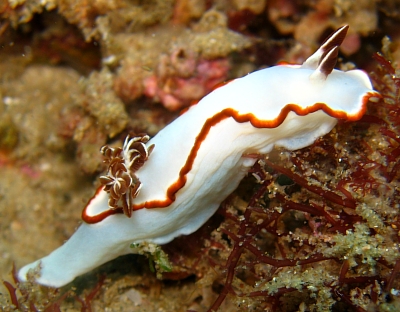
Dear Bruce,
They are all G. averni. The rhinophores and gills certainly don't appear to be black to me, the rhinophore clubs are brownish but the gills are certainly nearer the colour of the mantle edge. It is interesting that the animal in the lowest photo has quite brown pigmentation. Every now and then I see photos of an animal with a brown border without even the reddish tinge found in your animal. I have suspected they are a brown form of G. averni, and I think your lower two photos show a link between that brown form and the more usual colour form with a red or orange-red border. As to the degree of folding of the mantle edge, this varies in quite a few species of Glossodoris, wth larger animals often showing a much more folded mantle than younger animals.
It's also good to get the photo of the egg ribbon. From the relatively large eggs I would suspect this species has either a fairly short non-feeding larval stage [lecithotrophic] or perhaps young slugs hatch directly from the egg ribbon without a swimming veliger stage at all.
Best wishes,
Bill Rudman
Glossodoris averni? from Sydney
June 17, 2005
From: Nicholas Missenden
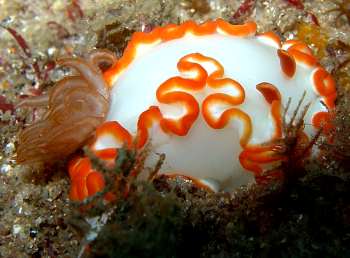
Hi again,
Just thought I would send you a picture of what I believe to be Glossodoris averni. If it is, then its another record for this species being found in Sydney waters.
Locality: Shark Point, Clovelley, Sydney, NSW, Australia. Depth: 22 m.
Length: 6 cm. 10 June 2005. Photographer: Nicholas Missenden
Thanks
Nick
njmpm@iinet.net.au
Nicholas, J.M., 2005 (Jun 17) Glossodoris averni? from Sydney. [Message in] Sea Slug Forum. Australian Museum, Sydney. Available from http://www.seaslugforum.net/find/14025Thanks Nick,
Nice to get another record of this species. It seems to be one of a group of species which seem to be endemic to the Coral Sea region - nthn New South Wales, southern Great Barrier Reef - although Jeff Rosenfeld's message [#8528] of an animal from the Philippines is a puzzle.
Best wishes,
Bill Rudman
Glossodoris averni from Philippines
November 30, 2002
From: Jeff Rosenfeld

Hi Bill,
Here's a shot of Glossodoris averni taken in Anilao, Luzon Island, Philippines in April, 2002. I suppose that means you can add the Philippines to the known distribution for this species.
Jeff
jhrosenfeld@seattleschools.org
Rosenfeld, J., 2002 (Nov 30) Glossodoris averni from Philippines. [Message in] Sea Slug Forum. Australian Museum, Sydney. Available from http://www.seaslugforum.net/find/8528Thanks Jeff,
This is an interesting extension to the known range of the species.
Best wishes,
Bill Rudman
Glossodoris averni from Sydney
December 1, 1998
From: Akos Lumnitzer
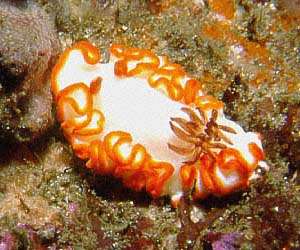
Dear Bill,
I saw this Glossodoris at Shark Point, Clovelly near the entrance to Botany Bay, Sydney, in about 23 metres, from July this year until it recently disappeared.
Is it usually found in Sydney?
Akos Lumnitzer.
AKOS72@hotmail.com
Lumnitzer, A., 1998 (Dec 1) Glossodoris averni from Sydney. [Message in] Sea Slug Forum. Australian Museum, Sydney. Available from http://www.seaslugforum.net/find/352Dear Akos,
Sydney is an interesting place because it is a convergence zone between the tropical northern fauna and the southern temperate fauna. New South Wales also has an endemic fauna derived from both elements.
The number of tropical species seen each year around Sydney depends on the strength and position of the southerly currents and eddies which can bring larval stages from tropical waters. It is a perilous journey for tropical mollusc larvae. Not only do they have to survive the perils of pelagic life and brave the cooler waters, but they have to be lucky enough to find some food that they are able to eat, once they settle out of the plankton. Those with very specialised diets will be dependent on the larvae of their tropical food also making the journey south. Some years there are many tropical species found, other years very few.
Your Glossodoris averni obviously survived the traumas and grew to a large size. Only when they reach their upper size range does the mantle become so folded and ruffled as in your photo. I can't recall G.averni being found as far south as Sydney before.
Bill Rudman.
Rudman, W.B., 1998 (Dec 1). Comment on Glossodoris averni from Sydney by Akos Lumnitzer. [Message in] Sea Slug Forum. Australian Museum, Sydney. Available from http://www.seaslugforum.net/find/352